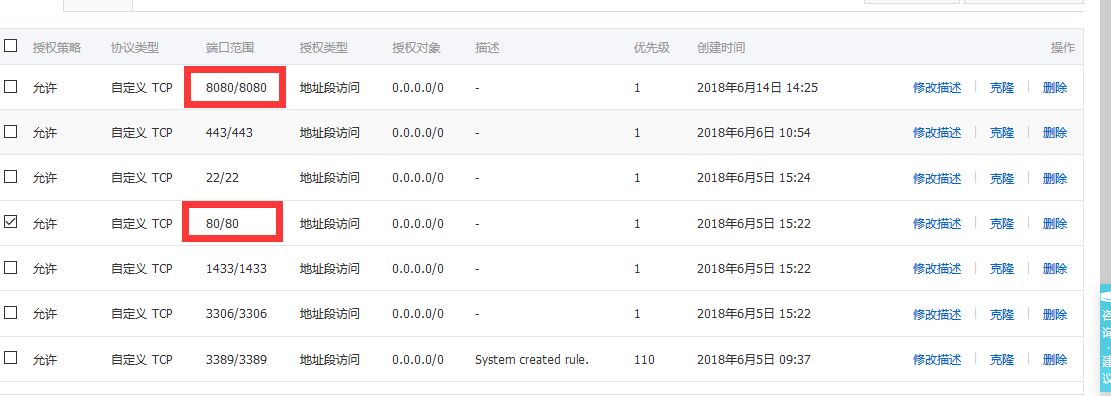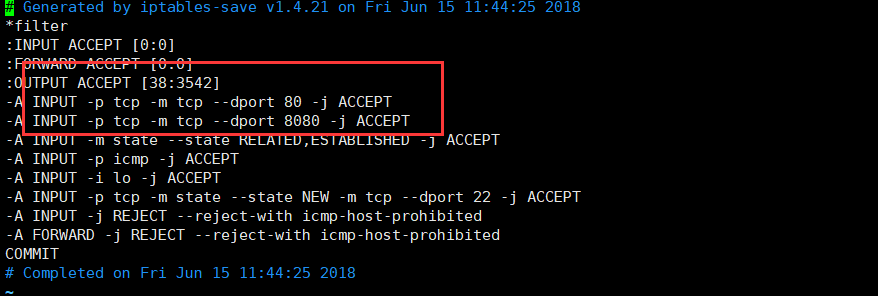阿里云linux镜像发布web项目时候 tomcat与域名映射
tomcat 与 域名映射
一 准备工作:
- 阿里云服务器Linux镜像 及 域名备案和将域名解析至服务器,通过<暂不说,网上一大把或者参考阿里官方实例手册>
- 在Linux镜像中安装tomcat+jdk环境,并将web项目打包上传至tomcat的webapps路径下
- 服务器开放80端口,及linux 镜像将80规则写入防火墙中



二:tomcat 映射域名 打开 tomcat的server.xml文件
- 1 将8080端口设置为80端口,直接映射80端口,为了省略项目访问时候输入端口号:8080

- 2设置域名及映射的项目名称,加入<context> 节点
注:这里是将项目方在webapps下 这段设置为 将域名:www.shangluo.store映射至 webapps/HelloWorld项目
<context >节点为自己加
<Context docBase="HelloWorld" path="" reloadable="true" > </Context>


保存退出 访问:你好世界!!

tomcat 配置:主要两点
1.8080 ---> 80
2.
<?xml version='1.0' encoding='utf-8'?>
<!--
Licensed to the Apache Software Foundation (ASF) under one or more
contributor license agreements. See the NOTICE file distributed with
this work for additional information regarding copyright ownership.
The ASF licenses this file to You under the Apache License, Version 2.0
(the "License"); you may not use this file except in compliance with
the License. You may obtain a copy of the License at http://www.apache.org/licenses/LICENSE-2.0 Unless required by applicable law or agreed to in writing, software
distributed under the License is distributed on an "AS IS" BASIS,
WITHOUT WARRANTIES OR CONDITIONS OF ANY KIND, either express or implied.
See the License for the specific language governing permissions and
limitations under the License.
-->
<!-- Note: A "Server" is not itself a "Container", so you may not
define subcomponents such as "Valves" at this level.
Documentation at /docs/config/server.html
-->
<Server port="" shutdown="SHUTDOWN">
<!-- Security listener. Documentation at /docs/config/listeners.html
<Listener className="org.apache.catalina.security.SecurityListener" />
-->
<!--APR library loader. Documentation at /docs/apr.html -->
<Listener className="org.apache.catalina.core.AprLifecycleListener" SSLEngine="on" />
<!--Initialize Jasper prior to webapps are loaded. Documentation at /docs/jasper-howto.html -->
<Listener className="org.apache.catalina.core.JasperListener" />
<!-- Prevent memory leaks due to use of particular java/javax APIs-->
<Listener className="org.apache.catalina.core.JreMemoryLeakPreventionListener" />
<Listener className="org.apache.catalina.mbeans.GlobalResourcesLifecycleListener" />
<Listener className="org.apache.catalina.core.ThreadLocalLeakPreventionListener" /> <!-- Global JNDI resources
Documentation at /docs/jndi-resources-howto.html
-->
<GlobalNamingResources>
<!-- Editable user database that can also be used by
UserDatabaseRealm to authenticate users
-->
<Resource name="UserDatabase" auth="Container"
type="org.apache.catalina.UserDatabase"
description="User database that can be updated and saved"
factory="org.apache.catalina.users.MemoryUserDatabaseFactory"
pathname="conf/tomcat-users.xml" />
</GlobalNamingResources> <!-- A "Service" is a collection of one or more "Connectors" that share
a single "Container" Note: A "Service" is not itself a "Container",
so you may not define subcomponents such as "Valves" at this level.
Documentation at /docs/config/service.html
-->
<Service name="Catalina"> <!--The connectors can use a shared executor, you can define one or more named thread pools-->
<!--
<Executor name="tomcatThreadPool" namePrefix="catalina-exec-"
maxThreads="" minSpareThreads=""/>
--> <!-- A "Connector" represents an endpoint by which requests are received
and responses are returned. Documentation at :
Java HTTP Connector: /docs/config/http.html (blocking & non-blocking)
Java AJP Connector: /docs/config/ajp.html
APR (HTTP/AJP) Connector: /docs/apr.html
Define a non-SSL HTTP/1.1 Connector on port
-->
<Connector port="" protocol="HTTP/1.1"
connectionTimeout=""
redirectPort="" URIEncoding="UTF-8" /> <!-- A "Connector" using the shared thread pool-->
<!--
<Connector executor="tomcatThreadPool"
port="" protocol="HTTP/1.1"
connectionTimeout=""
redirectPort="" />
-->
<!-- Define a SSL HTTP/1.1 Connector on port
This connector uses the JSSE configuration, when using APR, the
connector should be using the OpenSSL style configuration
described in the APR documentation -->
<!--
<Connector port="" protocol="HTTP/1.1" SSLEnabled="true"
maxThreads="" scheme="https" secure="true"
clientAuth="false" sslProtocol="TLS" />
--> <!-- Define an AJP 1.3 Connector on port -->
<Connector port="" protocol="AJP/1.3" redirectPort="" /> <!-- An Engine represents the entry point (within Catalina) that processes
every request. The Engine implementation for Tomcat stand alone
analyzes the HTTP headers included with the request, and passes them
on to the appropriate Host (virtual host).
Documentation at /docs/config/engine.html --> <!-- You should set jvmRoute to support load-balancing via AJP ie :
<Engine name="Catalina" defaultHost="localhost" jvmRoute="jvm1">
-->
<Engine name="Catalina" defaultHost="localhost">
<!--For clustering, please take a look at documentation at:
/docs/cluster-howto.html (simple how to)
/docs/config/cluster.html (reference documentation) -->
<!--
<Cluster className="org.apache.catalina.ha.tcp.SimpleTcpCluster"/>
--> <!-- Use the LockOutRealm to prevent attempts to guess user passwords
via a brute-force attack -->
<Realm className="org.apache.catalina.realm.LockOutRealm">
<!-- This Realm uses the UserDatabase configured in the global JNDI
resources under the key "UserDatabase". Any edits
that are performed against this UserDatabase are immediately
available for use by the Realm. -->
<Realm className="org.apache.catalina.realm.UserDatabaseRealm"
resourceName="UserDatabase"/>
</Realm> <Host name="www.shangluo.store" appBase="webapps"
unpackWARs="true" autoDeploy="true" > <Context docBase="HelloWorld" path="" reloadable="true" > </Context>
<!-- SingleSignOn valve, share authentication between web applications
Documentation at: /docs/config/valve.html -->
<!--
<Valve className="org.apache.catalina.authenticator.SingleSignOn" />
--> <!-- Access log processes all example.
Documentation at: /docs/config/valve.html
Note: The pattern used is equivalent to using pattern="common" -->
<Valve className="org.apache.catalina.valves.AccessLogValve" directory="logs"
prefix="localhost_access_log." suffix=".txt"
pattern="%h %l %u %t "%r" %s %b" /> </Host>
</Engine>
</Service>
</Server>
阿里云linux镜像发布web项目时候 tomcat与域名映射的更多相关文章
- 阿里云服务器购买 发布web项目全过程
http://blog.csdn.net/liona_koukou/article/details/50496946
- Maven发布web项目到tomcat
在java开发中经常要引入很多第三方jar包:然而无论是java web开发还是其他java项目的开发经常会由于缺少依赖包引来一些不必要的异常.常常也是因为这样的原因导致许多简单的缺包和版本问题耗费大 ...
- 如何在阿里云linux上部署java项目
前2天把git练了下,敲了很多命令,也借助图形界面增强自己的理解,乘着余热把linux在熟悉下.然后想起以前婷主有让我帮忙搭建的阿里云服务器,所以就想自己试着在阿里云的linux上搭建自己的jav ...
- 阿里云服务器部署Java Web项目全过程
最近需要将一个Java Web项目部署到服务器上,方便多人共享访问.这也是我第一次接触服务器之类的东西,也花了一点时间,最终总算部署成功,写下一篇文章记录以便日后回顾. 购买服务器 第一步当然是需要购 ...
- idea发布web项目在tomcat位置问题
(1)war模式这种可以称之为是发布模式,看名字也知道,这是先打成war包,再发布. (2)war exploded模式是直接把文件夹.jsp页面 .classes等等移到Tomcat 部署文件夹里面 ...
- 阿里云Ubuntu部署java web(2) - 配置tomcat
系统版本号:Ubuntu12.04 64位 安装: 首先要安装java(測试时使用的版本号是6b27-1.12.6-1ubuntu0.12.04.2).版本号可自行选择,但不同版本号配置方法可能不同. ...
- eclipse中tomcat使用add and remove无法发布web项目
继上次启动eclipse中的tomcat报classNotFound的问题后,这次又遇到新问题.就是右键点击tomcat使用add and remove发布web项目至tomcat后,启动tomcat ...
- 阿里云Ubuntu部署java web - 文件夹
文件夹(点击章节标题阅读): 阿里云Ubuntu部署java web(1) - 系统配置 ssh链接server(使用终端远程链接) 加入用户 给用户赋予运 ...
- Linux上部署web服务器并发布web项目-转
Linux上部署web服务器并发布web项目 近在学习如何在linux上搭建web服务器来发布web项目,由于本人是linux新手,所以中间入了不少坑,搞了好久才搞出点成果.以下是具体的详细步骤以 ...
随机推荐
- python_09
今日内容: scrapy各组件 Components: 1.引擎(EGINE) 引擎负责控制系统所有组件之间的数据流,并在某些动作发生时触发事件.有关详细信息,请参见上面的数据流部分. 2.调度器(S ...
- JavaWeb02-Servlet
Servlet概述 生命周期方法: l void init(ServletConfig):出生之后(1次): l void service(ServletRequest request, Serv ...
- 【Linux系列】Centos 7安装 Nginx(三)
目的 为了下面的Laravel部署,本篇开始安装Nignx服务器. 防火墙设置 在物理主机上查看nginx是否安装成功,需要开放虚拟机的80端口. 用cmder登录到虚拟机 firewall-cmd ...
- Android官方提供的支持不同屏幕大小的全部方法(转)
转载请注明出处:http://blog.csdn.net/guolin_blog/article/details/8830286 原文地址为:http://developer.android.com/ ...
- Java数组定义及初始化
数组定义及初始化 数组这玩意是一种用于存放数据最常见数据结构. 数组的的概念及注意点 数组要求所有的数组元素具有相同的数据类型,且只能存在一种数据类型,要多专一有多专一. 数据类型既可以是基本类型也可 ...
- 【集训Day1 测试】奇怪数
奇怪数(odometer) [题目描述] 一个正整数Z是奇怪数,当且仅当满足的条件是:Z的所有数字中,只有一个数字不同于其他数字.例如:33323.110 都是奇怪数,而 9779.5555 都不是奇 ...
- scrapy结合selenium抓取武汉市环保局空气质量日报
1.前言 目标网站:武汉市环境保护局(http://hbj.wuhan.gov.cn/viewAirDarlyForestWaterInfo.jspx).scrapy对接selenium模块抓取空气质 ...
- tensorflow:模型的保存和训练过程可视化
在使用tf来训练模型的时候,难免会出现中断的情况.这时候自然就希望能够将辛辛苦苦得到的中间参数保留下来,不然下次又要重新开始. 保存模型的方法: #之前是各种构建模型graph的操作(矩阵相乘,sig ...
- Fragment源码分析
转载请标明出处:http://blog.csdn.net/shensky711/article/details/53171248 本文出自: [HansChen的博客] 概述 Fragment表示 A ...
- 金蝶天燕中间拒绝put、delete请求解决方案
项目要求支持国产化,那就国产化呗!使用金蝶天燕中间件替代weblogic,一切部署好后发现所有以put.delete请求的按钮全部无效,原因是中间件配置文件默认拒绝put.delete请求 解决方案为 ...
